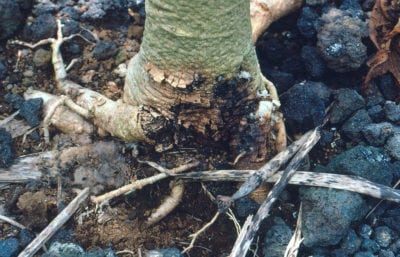
Papaya stem rot, sometimes also known as collar rot, root rot, and foot rot, is a syndrome affecting papaya trees that can be caused by a few different pathogens. Papaya stem rot can be a serious problem if not addressed properly. Keep reading to learn more about what causes papaya stem rot and tips for controlling papaya stem rot disease.
What Causes Papaya Stem Rot?
Stem rot on papaya trees is a syndrome rather than a specific disease, and it has been known to be caused by a number of different pathogens. These include Phytophthora palmivora, Fusarium solani, and multiple species of Pythium. These are all fungi that infect the tree and induce symptoms.
Papaya Stem Rot Symptoms
Stem rot, no matter the cause, tends to affect young trees the most, particularly when they have recently been transplanted. The stem of the tree will become water soaked and weak, usually right at ground level. This water-soaked area will develop into a brown or black lesion and begin to rot.
Sometimes a white, fluffy growth of fungus is visible. The leaves may turn yellow and droop, and eventually the entire tree will fail and collapse.
Controlling Papaya Stem Rot
The fungi that cause papaya stem rot thrive in damp conditions. Waterlogging of the tree’s roots is likely to lead to stem rot. The best way to keep the fungus from taking hold is to plant your papaya saplings in well-draining soil.
When transplanting, make sure the soil line is at the same level on the trunk that it was before – never build up the soil around the trunk.
When planting saplings, handle them with care. Injury to their delicate stems creates a gateway for fungi.
If a papaya tree shows signs of stem rot, it can’t be saved. Dig up infected plants and destroy them, and do not plant more trees in the same spot, as stem rot fungi live in the soil and will lie in wait there for their next host.
Papaya stem rot, sometimes also known as collar rot, root rot, and foot rot, is a syndrome affecting papaya trees that can be caused by a few different pathogens. Papaya stem rot can be a serious problem if not addressed properly. Keep reading to learn more about what causes papaya stem rot and tips for controlling papaya stem rot disease.
What Causes Papaya Stem Rot?
Stem rot on papaya trees is a syndrome rather than a specific disease, and it has been known to be caused by a number of different pathogens. These include Phytophthora palmivora, Fusarium solani, and multiple species of Pythium. These are all fungi that infect the tree and induce symptoms.
Papaya Stem Rot Symptoms
Stem rot, no matter the cause, tends to affect young trees the most, particularly when they have recently been transplanted. The stem of the tree will become water soaked and weak, usually right at ground level. This water-soaked area will develop into a brown or black lesion and begin to rot.
Sometimes a white, fluffy growth of fungus is visible. The leaves may turn yellow and droop, and eventually the entire tree will fail and collapse.
Controlling Papaya Stem Rot
The fungi that cause papaya stem rot thrive in damp conditions. Waterlogging of the tree’s roots is likely to lead to stem rot. The best way to keep the fungus from taking hold is to plant your papaya saplings in well-draining soil.
When transplanting, make sure the soil line is at the same level on the trunk that it was before – never build up the soil around the trunk.
When planting saplings, handle them with care. Injury to their delicate stems creates a gateway for fungi.
If a papaya tree shows signs of stem rot, it can’t be saved. Dig up infected plants and destroy them, and do not plant more trees in the same spot, as stem rot fungi live in the soil and will lie in wait there for their next host.
